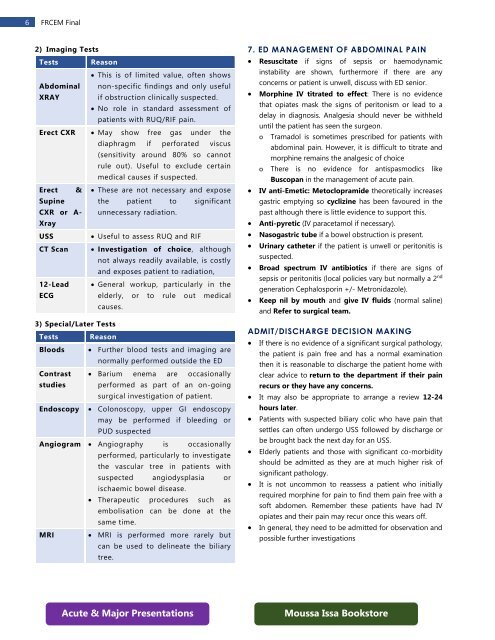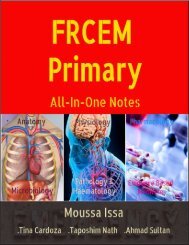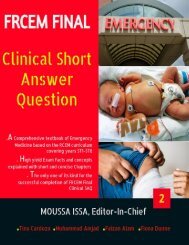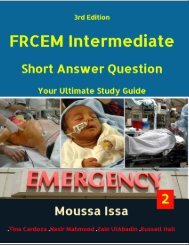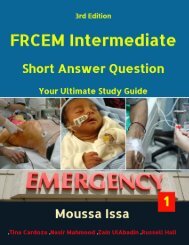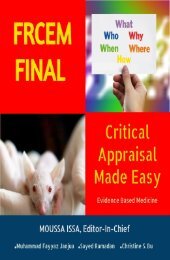FRCEM FINAL SBA eBook 1(Preview)
FRCEM FINAL SBA book is designed to present concise, easy-to-read, practical information on the diagnosis and treatment of a wide spectrum of conditions that present to the emergency department. The chapters emphasize the immediate management of life-threatening problems & then present the evaluation and treatment of specific disorders. In keeping with the curriculum spanning ST 1- ST 6 I have strived to provide the reader with a broad-based text written in a clear and point form manner. My goal was to not only provide practising emergency physicians quick access to accurate and useful information that will aid in their everyday practice of emergency medicine but also mainly to help trainees throughout their 6-year training in Emergency Medicine. Because this text focuses on the practical aspects of emergency care, there is little discussion of disease processes' basic science or pathophysiology. This is the only book of its kind available which covers the entire curriculum and helps prepare for the FINAL Clinical SAQ. The book will be useful to all practitioners of Emergency Medicine, including Physicians, Residents, Medical Students as well as Physician Extenders.
FRCEM FINAL SBA book is designed to present concise, easy-to-read, practical information on the diagnosis and treatment of a wide spectrum of conditions that present to the emergency department.
The chapters emphasize the immediate management of life-threatening problems & then present the evaluation and treatment of specific disorders.
In keeping with the curriculum spanning ST 1- ST 6 I have strived to provide the reader with a broad-based text written in a clear and point form manner.
My goal was to not only provide practising emergency physicians quick access to accurate and useful information that will aid in their everyday practice of emergency medicine but also mainly to help trainees throughout their 6-year training in Emergency Medicine.
Because this text focuses on the practical aspects of emergency care, there is little discussion of disease processes' basic science or pathophysiology.
This is the only book of its kind available which covers the entire curriculum and helps prepare for the FINAL Clinical SAQ.
The book will be useful to all practitioners of Emergency Medicine, including Physicians, Residents, Medical Students as well as Physician Extenders.
You also want an ePaper? Increase the reach of your titles
YUMPU automatically turns print PDFs into web optimized ePapers that Google loves.
6 <strong>FRCEM</strong> Final<br />
2) Imaging Tests<br />
Tests Reason<br />
• This is of limited value, often shows<br />
Abdominal<br />
XRAY<br />
non-specific findings and only useful<br />
if obstruction clinically suspected.<br />
• No role in standard assessment of<br />
patients with RUQ/RIF pain.<br />
Erect CXR • May show free gas under the<br />
diaphragm if perforated viscus<br />
(sensitivity around 80% so cannot<br />
rule out). Useful to exclude certain<br />
medical causes if suspected.<br />
Erect & • These are not necessary and expose<br />
Supine the patient to significant<br />
CXR or A- unnecessary radiation.<br />
Xray<br />
USS<br />
• Useful to assess RUQ and RIF<br />
CT Scan • Investigation of choice, although<br />
not always readily available, is costly<br />
and exposes patient to radiation,<br />
12-Lead • General workup, particularly in the<br />
ECG<br />
elderly, or to rule out medical<br />
causes.<br />
3) Special/Later Tests<br />
Tests Reason<br />
Bloods • Further blood tests and imaging are<br />
normally performed outside the ED<br />
Contrast • Barium enema are occasionally<br />
studies performed as part of an on-going<br />
surgical investigation of patient.<br />
Endoscopy • Colonoscopy, upper GI endoscopy<br />
may be performed if bleeding or<br />
PUD suspected<br />
Angiogram • Angiography is occasionally<br />
performed, particularly to investigate<br />
the vascular tree in patients with<br />
suspected angiodysplasia or<br />
ischaemic bowel disease.<br />
• Therapeutic procedures such as<br />
embolisation can be done at the<br />
same time.<br />
MRI • MRI is performed more rarely but<br />
can be used to delineate the biliary<br />
tree.<br />
7. ED MANAGEMENT OF ABDOMINAL PAIN<br />
• Resuscitate if signs of sepsis or haemodynamic<br />
instability are shown, furthermore if there are any<br />
concerns or patient is unwell, discuss with ED senior.<br />
• Morphine IV titrated to effect: There is no evidence<br />
that opiates mask the signs of peritonism or lead to a<br />
delay in diagnosis. Analgesia should never be withheld<br />
until the patient has seen the surgeon.<br />
o<br />
o<br />
Tramadol is sometimes prescribed for patients with<br />
abdominal pain. However, it is difficult to titrate and<br />
morphine remains the analgesic of choice<br />
There is no evidence for antispasmodics like<br />
Buscopan in the management of acute pain.<br />
• IV anti-Emetic: Metoclopramide theoretically increases<br />
gastric emptying so cyclizine has been favoured in the<br />
past although there is little evidence to support this.<br />
• Anti-pyretic (IV paracetamol if necessary).<br />
• Nasogastric tube if a bowel obstruction is present.<br />
• Urinary catheter if the patient is unwell or peritonitis is<br />
suspected.<br />
• Broad spectrum IV antibiotics if there are signs of<br />
sepsis or peritonitis (local policies vary but normally a 2 nd<br />
generation Cephalosporin +/- Metronidazole).<br />
• Keep nil by mouth and give IV fluids (normal saline)<br />
and Refer to surgical team.<br />
ADMIT/DISCHARGE DECISION MAKING<br />
• If there is no evidence of a significant surgical pathology,<br />
the patient is pain free and has a normal examination<br />
then it is reasonable to discharge the patient home with<br />
clear advice to return to the department if their pain<br />
recurs or they have any concerns.<br />
• It may also be appropriate to arrange a review 12-24<br />
hours later.<br />
• Patients with suspected biliary colic who have pain that<br />
settles can often undergo USS followed by discharge or<br />
be brought back the next day for an USS.<br />
• Elderly patients and those with significant co-morbidity<br />
should be admitted as they are at much higher risk of<br />
significant pathology.<br />
• It is not uncommon to reassess a patient who initially<br />
required morphine for pain to find them pain free with a<br />
soft abdomen. Remember these patients have had IV<br />
opiates and their pain may recur once this wears off.<br />
• In general, they need to be admitted for observation and<br />
possible further investigations<br />
Acute & Major Presentations<br />
Moussa Issa Bookstore


